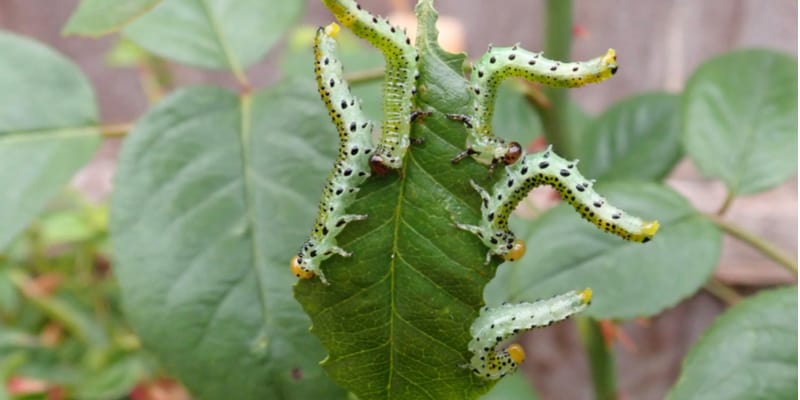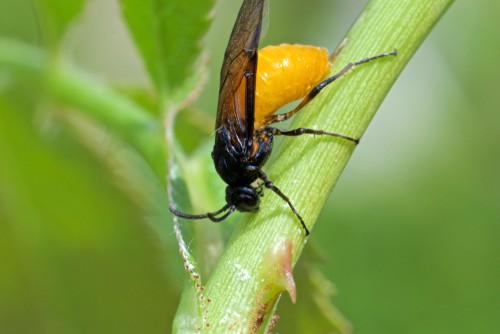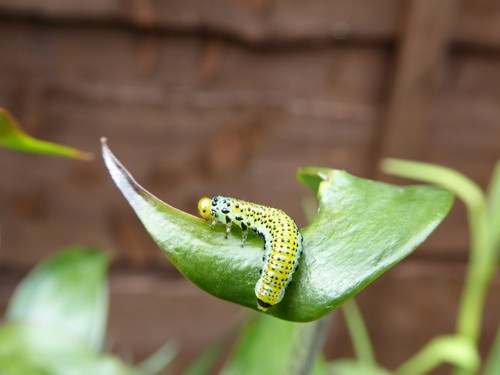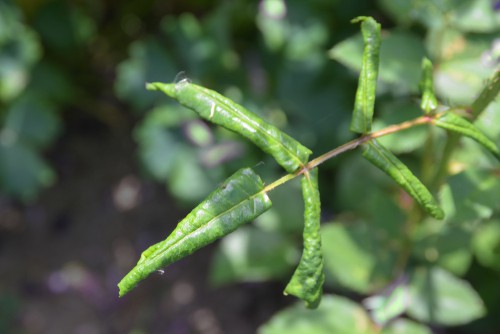
Caterpillars on Roses – Killing Rose Sawfly Larvae
Our site is reader supported, this means we may earn a small commission from Amazon and other affiliates when you buy through links on our site.
Your beautiful roses have been thriving and then all of a sudden you start noticing that the leaves are curling inwards or outwards, scars on the stems or holes in the leaves. You look for the root of the problem and discover rose sawflies are plaguing your roses. It is actually a fairly common problem, so what do you need to do?
How do you deal with rose sawflies without causing further damage to your roses? In this guide, I tell you how to identify rose sawflies and what to do to prevent them from taking over your roses. Let us dive right in:
What do rose sawflies look like?
Rose sawflies scientifically known as Arge ochropus, are insects that can be found on several continents. Before rose sawflies become adults measuring around 10mm, they remain as caterpillars at the larvae stage. At this point, they feed in plenty to provide energy for the next stage of metamorphosis and this is why you may find them infesting your roses and when the issue starts to really stand out.
They lay the eggs on the leaves and then the caterpillars grow, harvesting nutrients from the foliage. As they eat the leaves, you will begin to notice that the leaves curl as well as spotting holes, which in the long term can be detrimental to the plant.
At the caterpillar stage, rose sawflies bear a pale colouring with yellow and black spots. If left unchecked, sawflies lead to defoliation, especially in large numbers. Once metamorphosed into adult sawflies, the insects bear a black head, reddish-orange wings, and a yellow abdomen but it’s the larvae that cause all the damage.
Why are rose sawflies are detrimental to your roses?
Roses are beautiful flowers that are mostly cultivated for decorative purposes. When roses are infested with rose sawflies, the aesthetic appeal usually declines due to holes caused by bite marks, they can literally strip all the leaves from a plant if they are left unchecked. Typically appearing around Spring, rose sawflies work through the leaves before finally consuming the petals.
Rose sawflies will not kill off your roses but they will diminish the plants’ ability to make food and this is because leaves are responsible for energy production. Apart from affecting the leaves, rose sawflies also make the plant prone to other insect infestations and diseases.
How can you tell if they are rose sawflies?
To avoid confusion with other caterpillar larvae species, it is vital to know how to identify rose sawflies. You can tell that they are rose sawflies because they lay their eggs inside soft stems. These eggs cause the stem to split open creating elongated scars on the stems.
Another indication is curled leaves caused by the caterpillars eating the leaves and leaving behind a chemical trail. You will also notice that the leaves develop yellow and black spots that eventually cause them to fall off especially during the Summer.
Managing sawflies before they completely damage your plants
A mild infestation will not harm your roses; however, if the rose sawflies are in great numbers (which they sometimes are) then you need to take action.
Here are a few steps you can use
- You can try removing them by hand and disposing of them how you see fit. Also, be on the lookout for scars on the stems and remove the stems before the eggs mature to prevent further infestation.
- Alternatively, purchase botanical pesticides with natural pyrethrins to kill them off, but if you would prefer more organic methods, you can spray soapy water on the leaves and stems.
- Neem oil and water spray can also be of great assistance if you want to keep the soil free from toxins. To make one litre of neem oil, you need a litre of warm water, 2ml of liquid soap, and 5ml of neem oil. Mix all the components up, shake well, and it is ready to use.
- Diatomaceous earth is another possible solution that can be purchased online or from local stores. It works by dehydrating the eggs and insects thus forcing them to die off without causing harm to the environment.
- Using birds as a means of control is also possible because they are natural predators of insects. If you have chicken around or currawong, let them feast on the caterpillars.
- Other insects such as ladybugs and ground beetles can also be utilised to combat rose sawflies. Believe it or not, you can actually purchase them on Amazon too. You can purchase these insects and introduce them in your garden as a long-term control measure.
You can also read this article on the most common pests and diseases that attack roses
Remember, regardless of whether you use chemical pesticides (this is my method of attack) or organic methods; you need to make several applications to manage the infestation. Be sure to eradicate the eggs of the insects to prevent future infestations.
If you choose to utilise chemical pesticides, please read the instructions provided to avoid oversaturating the soil with chemicals. Spray at intervals rather than one heavy application so that you systematically kill them off without missing any spots.
Rose sawflies only have a life span of 7-9 days once matured but the larvae stage takes a few months. It is easier to tackle rose sawflies by eliminating the eggs as soon as possible before they turn to larvae. After all, prevention is always better than cure, so be on the lookout.


